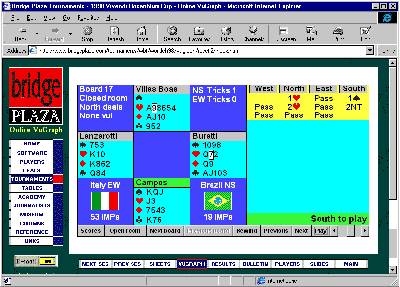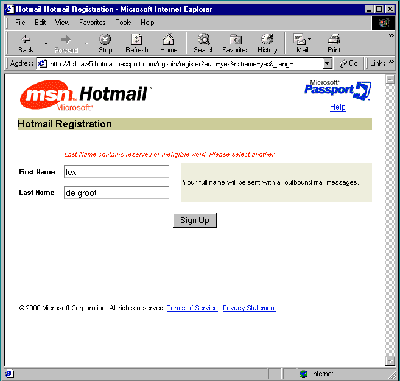Building Bridges
Meanwhile, Mark is sitting in the Grand Palais, a conference centre in Lille, France. Here the World Bridge Championships are being held for two weeks. Why should he be there, as he doesn’t even play Bridge? Well for his sins Mark is the IT manager for the World Bridge Federation for this event and has been for others in the past. This means that he has to set up and maintain some of the computer systems used during such a championship. For an event like this there is just over 300K of internet connection as not only are there are at least 4 major Bridge web sites being updated from the event, the worlds Press also need to keep in touch with email and web access. There have been matches played here via the Internet. Both OKBridge (www.okbridge.com) and the Microsoft gaming zone (www.zone.com) were demonstrating how the game of bridge is played over the internet against other ‘real’ players. This is a fast growing area of the sport with many teaching possibilities as the game of bridge has many levels of complexity. On the Microsoft site (which is just about to launch a new downloadable version of their free service) they have computer ‘bots’ that will play with and against you, if you can not or do not wish to play against real players. Both systems have chat channels with the concepts of ‘friends’ so that you can bookmark people and you will be informed if they come on line. One spectator cruelly suggested to a representative that perhaps they could add ‘friend bots’ for players who did not have any real friends, so that messages such as ‘Hey it’s great to see you again’ and ‘Wow what a great game you played’ would be generated by these ‘bots’. A number of commercial sites are also here showing off their goods via the ‘net. Even the play and bidding of many of the hands can be replayed and examined via Java technology on the Bridge Plaza site (www.bridgeplaza.com).

Replay matches via a Java client
It is quite incredible to remember that at the last such tournament of this size just four years ago, the internet was still in it’s infancy with only the most technologically savvy of the journalists having modems for email. During this Championship even the general public and players have free Internet access, again something that is becoming demanded and expected.
The Internet connection has been provided by France Telecom and consists of 6 ISDN lines aggregated to a Cisco Router, this is connected to the internal LAN. There is always a problem with Email accounts at these tournaments. Many people arrive without the details to set up email clients for their own mailboxes. However this year we decided to we use the excellent HotMail service provided now by Microsoft (www.hotmail.com).

So good, Microsoft bought the company!
This service gives you a free email account which can be accessed simply from any web browser anywhere there is an internet connection, in exchange for filling out half a dozen questions on a simple registration form. Not only this, but you can configure your hot-mail account to collect the email from up to 4 POP3 email accounts, thus giving you the ability to check your main email account via a web page should your provider not offer this service. Hot-Mail has certainly made Mark’s job a lot easier with many people appreciating the ease of collecting their email this way. As there are over four thousand players at this event, the previous hassle of configuring email clients, and keeping them configured has been considerably reduced.
A New Suit
An interesting point was raised by one of the web site developers here. Many Bridge sites when displaying suit symbols will use a small gif. Now these images are small and are of course cached and so have no noticeable hit on performance. However what does cause a problem is the HTML needed to define each symbol. For a graphic you need something like:
<img src="\images\spade.gif" width = 50 height = 50 alt="Spade">
Whereas this site developer has come up with a solution of using the symbol font. So the revised code is:
<FONT FACE="Symbol">ª</FONT>
This gives a saving of 30 bytes every time a suit symbol is used and as a hand diagram in bridge showing all the cards that the four players hold, will use 16 suit symbols and more in the descriptive text this technique can result in a saving of at least 480 bytes. Considerably more if the path to your graphic is longer which it invariably is. Now whilst not many of you use suit symbols on your web sites to this extent, we thought that it was an interesting point that the size of the graphic is not the only concern when designing web pages which are optimized for a fast download. The length of HTML code may also make a difference. The solution that was used to illustrate this, is fine if the pages are viewed on a machine with this particular symbol font installed. In this case every windows machine. However other operating systems, Unix for example will display other characters instead of the suit symbols. This is going against the purity of ideal, of exchanging information between differing platforms via the internet, but as over 95% of their viewers are using Windows as an operating system then the solution is a viable one in their view. Many of the WYSIWYG design tools approach the job of HTML code generation, particularly of tables, with a ‘sledge hammer’ approach and insert formatting tags for every cell rather than using a default setting for the entire table. This not only makes the code difficult to read but also increases file sizes, hence download times as well as increasing the time it takes for the browser to render the table. The solution to this is to optimize the HTML code of your pages by going in with a text editor to strip out the unnecessary tags. How ever as soon as you reload this page into your favorite WYSIWYG editor then in most cases the superfluous code is put back it. Should any one company create a product that truly does not alter your hand written code, or at least tells you before it does, preferably with a description of what it is about to do, then as they say, we are sure that ‘the world will beat a path to their door’.
Cracks and tips
In a previous article we wondered how long it might take to ‘crack’ a DESII – 56 key encryption code. Well, a reader, Geoff Hoare, informed us that this code was cracked in less than 3 days using a dedicated machine. For more information on this take a look at (www.ef.org/descracker.html). This short period of time taken to crack a supposed securely encrypted message just lends fuel to our argument that Europe needs a decent level of encryption (say 128 bit) before the majority of people will feel happy to use on–line commerce.

A wealth of information on Microsoft web technology
Here’s a useful
tip that we picked up from the Microsoft site the other day (wwww.microsoft.com/workshop).
We all know that the # in HTML indicates a bookmark.
So the URL http://www.mysite.com/a_page.html#mybookmark will not only load the page ‘a_page.html’, but instead of being positioned at the top of the page,
the browser will put the bookmark at the top of the browser window.
Ok this is all well and good but hardly anything new.
However if you try something like: http://www.mysite.com/frame.html#mypages/a_page.html This will load the html page ‘mypages/a_page.html’ into the frameset frame.html.
Now this strikes us as being a very useful trick particularly if the URL is generated as a result of a query.
Then the pages loaded into a frameset can be changed dynamically as a result of a
users selection or the result of a database query.